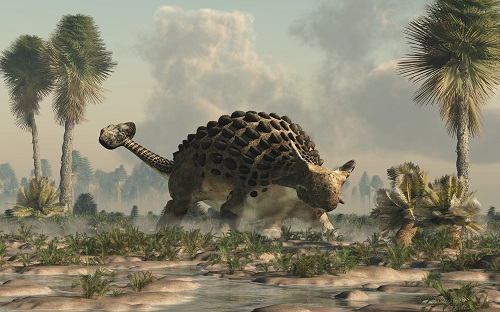
Cretaceous era
The Cretaceous period spanned approximately 145 million to 66 million years ago, making it nearly 80 million years long—significantly longer than the Triassic and Jurassic periods. Although the name may sound whimsical, it has a logical origin. In Europe, numerous dinosaur fossils from this period are discovered within layers of limestone. Limestone typically exhibits a bright white color, resembling chalk on a blackboard. The iconic chalk cliffs of the English coast serve as a prime example of this limestone formation.
New animals and plants
During the Cretaceous period, the Earth experienced a significantly warmer and more humid climate compared to the present day. This created favorable living conditions for a wide range of animals and plants. While some dinosaur species became extinct towards the end of the Jurassic period, the Cretaceous period saw the emergence of new species. Many dinosaurs in the Cretaceous period developed distinct features such as horns around their mouths or beak-like structures. One of the most iconic dinosaur species, the Tyrannosaurus Rex, also evolved during this time and reigned as the apex predator, occupying the top of the food chain.
The Cretaceous period was not only a fruitful era for dinosaurs but also for mammals. Although most mammals during this period were relatively small, not exceeding 15 centimeters in size, numerous new species emerged. These included mammal-like creatures resembling hamsters or guinea pigs. Many mammals in the Cretaceous period were nocturnal, which provided them with a level of safety from carnivorous dinosaurs. In addition to the diversification of animal species, the Cretaceous period witnessed the emergence of new plants. One of the most significant developments during this era was the evolution of flowering plants and trees. Prior to the Cretaceous, flowers did not exist, and plants relied on alternative methods for reproduction. With the proliferation of mammals, flowering plants, and trees, nature during the Cretaceous period became increasingly similar to the recognizable forms we see today.
The end of the dinosaurs
The Cretaceous period came to an end around 66 million years ago with a monumental mass extinction event, possibly the largest in history. This mass extinction was likely triggered by a meteorite impact. Evidence of this event was found in Mexico, where a crater revealed that the meteorite had a diameter of approximately 30 kilometers! The impact, along with ensuing fires, resulted in the deaths of numerous animals, and its effects were felt worldwide. The meteorite impact released an immense amount of dust into the atmosphere, blocking sunlight from reaching the Earth’s surface across the globe. Without sunlight, plants could not thrive, leading to the starvation of large herbivores. Consequently, the scarcity of food caused the decline of large predatory dinosaurs as well. Only a few small species of flying dinosaurs, often referred to as avian dinosaurs, managed to survive. Scientists believe that these dinosaurs are the ancestors of modern-day birds. It is remarkable to note the striking resemblance between some dinosaurs and birds.
While it is regrettable that dinosaurs became extinct, their disappearance allowed small and vulnerable mammals to rise as the dominant group of animals in the post-Cretaceous era. With the settling of the dust clouds and the absence of large predators, ample food resources became available. This facilitated the development and evolution of small mammals, eventually leading to the emergence of humans.

Follow us on TikTok
Wondering what your dino-friends get up to when you’re not around? Follow the adventures of your favourite dinosaurs on TikTok and other social media platforms!
Follow us on social media